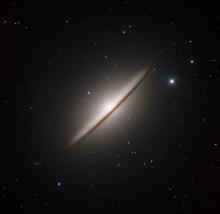Listen to today's episode of StarDate on the web the same day it airs in high-quality streaming audio without any extra ads or announcements. Choose a $8 one-month pass, or listen every day for a year for just $30.
You are here
Active Galaxies
The center of our home galaxy, the Milky Way, is pretty quiet. The supermassive black hole that lurks there isn't “feeding,” so it doesn't produce much energy.
That’s not the case for many other large galaxies, though. As many as a billion of them could be classified as active galaxies — their central black holes are generating enormous amounts of energy.
The black holes themselves aren’t actually producing the energy. Nothing comes out of a black hole, so it stays black. Instead, an active galaxy’s black hole — which is millions or billions of times the mass of the Sun — is pulling in big clouds of gas and dust, along with occasional stars.
As this material spirals toward the black hole, it forms a disk that’s heated to millions of degrees. At that temperature, the disk emits a lot of energy. Some of it is in the form of visible light, but much of it is in the ultraviolet and X-ray portions of the electromagnetic spectrum.
Some active galaxies also spew out long jets of gas that are moving at close to the speed of light. The jets produce radio waves, so the galaxy can shine brighter at radio wavelengths than any other form of energy; more about that tomorrow.
An active galaxy doesn’t stay active. Energy from the disk can blow away surrounding clouds of gas and dust. That deprives the black hole of food, so it shuts down. The black hole is still there, though, waiting to grab a passing star or gas cloud — once again turning its host into an active galaxy.
Script by Damond Benningfield





